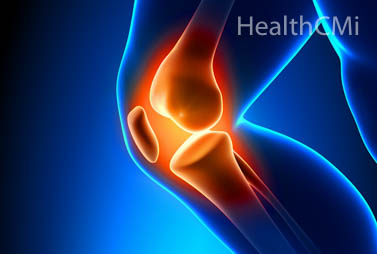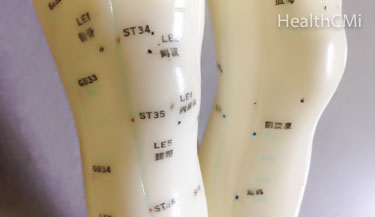Acupuncture improves knee recuperation after surgery. Researchers investigated the effects of acupuncture on patients that received arthroscopic meniscus surgical repair.  The meniscus is fibrous cartilage that cushions impact and stabilizes the knee. Each knee has two menisci, one medial and one lateral. A torn meniscus may require surgical repair as is the case with patients in this study. Symptoms often include knee popping, swelling, stiffness, pain, difficulty straightening, or obstruction of movement.
The meniscus is fibrous cartilage that cushions impact and stabilizes the knee. Each knee has two menisci, one medial and one lateral. A torn meniscus may require surgical repair as is the case with patients in this study. Symptoms often include knee popping, swelling, stiffness, pain, difficulty straightening, or obstruction of movement.
In this randomized investigation, one group received acupuncture plus physical therapy and another group received only physical therapy. The researchers found that the group receiving acupuncture combined with physical therapy had significantly greater positive patient outcomes than the group that did not have acupuncture treatments.
Robotics
The group receiving acupuncture demonstrated significantly greater improvements in knee joint energy, support torque, and swing torque. The measurements were taken on the acupuncture and non-acupuncture groups one month after treatment and at an additional assessment two months after treatment. Measurements were recorded using Lokomat gait assessment equipment, a highly advanced robotic functional therapy system. The state of the art Lokomat therapy system provided the research team with continuous feedback and precise therapy assessment.
Patients were treated at the rehabilitation department of the Second Hospital Affiliated to Luohe Medical College in Henan, China. Patients in both the non-acupuncture group and the acupuncture group performed identical physical rehabilitation exercises.  Patients performed passive joint motions, knee joint control, stance balance, gait training and other rehabilitation exercises. The physical therapy sessions were once per day for a total of two months.
Patients performed passive joint motions, knee joint control, stance balance, gait training and other rehabilitation exercises. The physical therapy sessions were once per day for a total of two months.
Acupuncture Points
The acupuncture group received acupuncture one time per day for a total of two months. The acupuncture points used in the study were:
- Dubi (ST35)
- Liangqiu (ST34)
- Xuehai (SP10)
- Zusanli (ST36)
- Xitong (Extra)
ST35 is an acupuncture point located in the lateral hollow below the patella, formed when the knee is flexed. Also referred to as lateral Xiyan, this acupuncture point is commonly used in the treatment of knee disorders. ST34, located 2 cun proximal to the latero-superior border of the patella, was also used. Locating this point is simplified in that the patella is 2 cun in length and the point may be located one patella’s length above the patella. ST34 is located on the line between the anterior superior iliac spine (ASIS) and the latero-superior aspect of the patella.
SP10 was also needled. This point is located directly above SP9 in the depression 2 cun proximal to the superior border of the patella. This point is both local to the knee region and is commonly used in Traditional Chinese Medicine (TCM) for the treatment of disorders characterized by blood stasis or heat in the blood. ST36, located 3 cun below ST35 and one finger-breadth lateral to the anterior crest of the tibia, was also applied.
Xitong, an extra point, was applied during the acupuncture treatments. This distal point is located 1 cun lateral to Quchi (LI11). The researchers note that needling Xitong functions to “relax tendons.” The local points were applied and retained for 30 minutes followed by needling the distal point, Xitong.
Efficacy
The randomized controlled study demonstrated that combining acupuncture with physical therapy improves knee joint energy, support torque, and swing torque when recuperating from arthroscopic meniscus surgery. The researchers conclude, “This indicates that, compared with rehabilitation training alone, acupuncture combined with rehabilitation training can better improve the patients’ knee joint support and swing torques after meniscus arthroscopy, correct their abnormal gaits, increase their motor function of the lower limb and benefit the balance abilities of their lower limbs during walking.”
References:
Liu, Xin-rong, and Qi Li. "Effect of acupuncture combined with rehabilitation training on walking function after arthroscopic meniscus repair." Journal of Acupuncture and Tuina Science 2, no. 13 (2015): 125-128.
State Administration of Traditional Chinese Medicine. Criteria of Diagnosis and Therapeutic Effects of Diseases and Syndromes in Traditional Chinese Medicine. Nanjing: Nanjing University Press, 1994: 205.
Shao ZH, Zhang YF, Lü H, Bi X, Gao LL, Liu XL, Huang XN. The impact of knee functions and muscles strength of isokinetic for patients with knee meniscus after arthroscopic surgery. Zhongguo Yiyao Xuekan, 2014, 16(4): 612-613.
He LQ, Wang Y. Rehabilitation training and Chinese traditional medicine improves the knee function of athletes after surgical treatment of meniscus injury. Chin J Sports Med, 2013, 32(9): 784-787.


